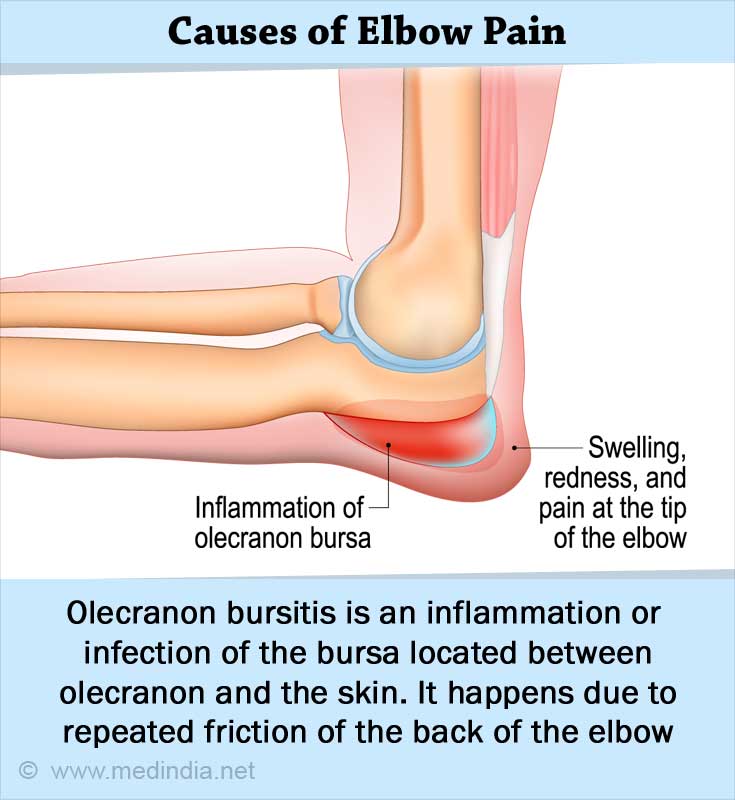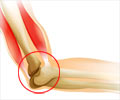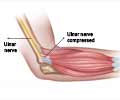- Elbow pain - (http://www.nlm.nih.gov/medlineplus/ency/article/003172.htm)
- Staph infections - (http://www.mayoclinic.org/diseases-conditions/staph-infections/basics/symptoms/con-20031418)
What is Elbow Pain?
Elbow Pain is a common complaint in both young and older population. It is often due to over use or strain of the muscles, ligaments and tendons in the elbow joint.
It is not serious if it is occasional, but if it is persistent or occurring even after rest, then it should be evaluated and treated for the cause.
The elbow connects the upper arm and forearm. The upper part of the joint is formed by the lower end of the arm bone, called the humerus. The lower end is formed mainly by the upper end of the ulna, and partly by the head of the radius, both bones of the forearm. The tip of the elbow which projects outward and often gets hit is called the olecranon. The projections on the inner and outer side are called medial and lateral epicondyle, respectively. The extensor muscles of the forearm are attached to the lateral epicondyle via the common extensor tendon, while the flexor muscles are attached to the medial epicondyle via the common flexor tendon. Below the medial epicondyle runs the ulnar nerve.
Common conditions in which elbow pain can occur are:
- Tennis elbow or lateral epicondylitis – It is the inflammation or degeneration of tendon tissue of the extensor muscles attached to the lateral epicondyle. Pain is commonly located over the outer side of the elbow. Pain increases with gripping or twisting activity. The condition is commonly seen in tennis players and other sportspersons, though it may also affect those who are not involved in sports but involved in repetitive twisting movements at the elbow joint. Physical examination and X – rays help in concluding the cause.
- Golfers elbow or medial epicondylitis – It is due to inflammation of the tendon of the flexor muscles attached to the medial epicondyle. It causes pain on the inner side of the elbow which increases with gripping. Physical examination and X – rays help in concluding the cause.
- Olecranon bursitis – It is the inflammation or infection of the bursa located between olecranon and the skin; the bursa normally acts as a cushion between the skin and the olecranon. Olecranon bursitis can happen due to repeated friction at the back of the elbow. It could also arise due to infection, trauma, or conditions like rheumatoid arthritis and gout. It presents with pain, swelling and warmth at the back of the elbow. Physical examination, x–rays and blood tests are helpful in concluding on the cause.

- Fracture of the elbow bones – Direct blow to the elbow or a fall can cause fractures to various bones in the elbow joint causing elbow pain. Olecranon fracture, radial head and neck fractures, coronoid process fracture, distal humerus fracture, intercondylar fracture, condylar fractures and elbow dislocation are some of the common injuries depending on their exact location in the elbow. The patient complains of severe pain, swelling and inability to move the elbow joint. Physical examination and x rays are useful in concluding the cause.
- Sprain – It can happen due to a forceful twisting injury or a fall on an outstretched arm causing stretching or tearing of a ligament in the elbow joint. It presents with swelling, pain, bruising, warmth, reduced degree of motion in the joint and tenderness over the elbow joint.
- Arthritis – Arthritis due to any cause like rheumatoid arthritis, psoriasis, gout or osteoarthritis can affect the elbow joint. It presents with pain, swelling, stiffness, reduced range of motion, tenderness and warmth over the joint. Physical examination, blood work, and imaging tests are useful in arriving on the diagnosis.
- Infections – Bacterial infections entering the blood can cause septic arthritis affecting various joints like knees, ankle, elbow, hip, wrist, shoulder and spine. The infection can occur from a localized source of infection entering blood stream or injury or after a surgery as a complication. Common symptoms include sudden severe pain in the elbow, swelling, warmth and fever. Blood work and X- rays are used to arrive on the diagnosis.
- Nerve entrapment/injury – Nerve entrapment or compression syndromes arise due to compression of the nerves that pass through the elbow towards the forearm namely median, ulnar and radial nerves. Most commonly, the ulnar nerve is affected; this condition is also called as Cubital tunnel syndrome. It presents with numbness, tingling sensation in the ring and little fingers of the hand on the affected side. Weakness, claw like fingers can also occur in this condition. When the radial nerve is affected, the condition is called radial tunnel syndrome. Symptoms are pain on the outer side of the elbow travelling towards the fore arm.
- Both these conditions are diagnosed with physical examination, nerve conduction studies (NCS) and electromyography (EMG).
- Pseudogout – It is a condition in which calcium pyrophosphate crystals are deposited in the joint space causing inflammation and damage to the cartilage. Swelling, pain and warm sensation over the elbow joint are common symptoms. Pseudogout may occur due to various factors like hyperparathyroidism, hemochromatosis, hypomagnesemia, hypothyroidism, hypercalcemia. Aging and genetic factors can also influence the occurrence of pseudogout. Diagnosis may be done with X – rays and examination of joint fluid under a polarizing microscope.
Other conditions that can give rise to elbow pain include:
- Tumors at the elbow
- Osteochondritis dessicans
- Rupture of the lower end of the biceps or triceps muscle
How to Diagnose Elbow Pain?
Elbow pain is often diagnosed with history of symptoms and physical examination. Investigations like X- rays, CT scan/ MRI scan and nerve studies like EMG/ NCS are useful for confirming the cause.
What Treatments are Available for Elbow Pain?
Treatment depends upon the cause. Some of the general methods for treating elbow pain are NSAIDs, steroid injections, platelet rich plasma injections, surgery and physiotherapy. Few cases might require surgery and it is most commonly done through key hole surgery method. In case of fractures or muscle tears, depending upon severity, surgery might be required. If healing is delayed or misalignment has occurred, it may lead to elbow arthritis. It is managed either with key hole surgery or open surgery. Physiotherapy is followed after surgery. In case of nerve entrapment, surgery to decompress the nerve is performed to retain the function of the nerve.

Health Tips
- Rest – In case of pain with a certain activity, it is important to take rest for the pain to subside and resume the activity. Also, practicing an alternative technique of doing that activity might help.
- Lifestyle modification – Pain that arises while playing tennis or squash is due to repetitive movements in the elbow joint. Hence, practicing an exercise schedule comprising of warm up, stretching and cooling down exercises helps cope with the situation.
- Using splint – Use a brace or splint to provide support during repetitive arm movements.
- Physiotherapy – Exercises to strengthen forearm muscles are useful in preventing elbow pain.
- Heating pad/ Cool compress – You can apply a heating pad or a cool compress for relief from pain.
Frequently Asked Questions (FAQs)
1. Which doctor should I consult for elbow pain?
You should consult an orthopedician for elbow pain.
2. What if I have persistent pain even after taking rest, using NSAIDs and steroid injections for tennis elbow?
Your doctor might suggest platelet rich plasma injections for relief. This is done by taking your blood sample and treating it to increase the number of platelets in comparison with other cells in the sample. This sample is again reinjected to speed up the healing process.
3. How can I prevent recurrence of elbow pain?
If certain activity has lead to elbow pain, you need to take rest until the pain subsides before resuming the activity. Also, applying a heating pad / cool compress, using a brace and including stretching exercises for elbows in your work out schedule are a great deal of help for preventing elbow pain.
4. What could be causing claw like ring and little fingers of the hand with numbness?
It could be due to cubital tunnel syndrome. In this condition, the ulnar nerve is compressed either due to pressure on it from the bone or due to narrowing of the tunnel through which it passes.










